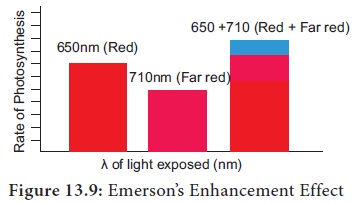Photosynthesis | Botany - Emerson's Experiments and Hill's Reaction | 11th Botany : Chapter 13 : Photosynthesis
Chapter: 11th Botany : Chapter 13 : Photosynthesis
Emerson's Experiments and Hill's Reaction
Emerson’s Experiments and Hill’s
Reaction
1. Red Drop or Emerson’s First Effect
Emerson conducted experiment in Chlorella using only one wavelength of light (monochromatic light) at a time and he measured quantum yield. He plotted a graph of the quantum yield in terms of O2 evolution at various wavelengths of light. His focus was to determine at which wavelength the photochemical yield of oxygen was maximum. He found that in the wavelength of 600 to 680 the yield was constant but suddenly dropped in the region above 680 nm (red region). The fall in the photosynthetic yield beyond red region of the spectrum is referred as Red drop or Emerson’s first effect.
2. Emerson’s Enhancement Effect
Emerson
modified his first experiment by supplying shorter wavelength of light (red
light) along with longer wavelength of light (far red light). He found that the
monochromatic light of longer wavelength (far red light) when supplemented with
shorter wavelength of light (red light) enhanced photosynthetic yield and
recovered red drop. This enhancement of photosynthetic yield is referred to as
Emerson’s Enhancement Effect (Figure 13.9).

Photosynthetic
rate at far red light (710 nm) = 10
Photosynthetic
rate at red light (650 nm) = 43.5
Photosynthetic
rate at red + far red (650 + 710 nm) = 72.5 (Enhancement effect).
3. Hill’s Reaction
R. Hill (1937) isolated chloroplasts and when they were illuminated in the
presence of suitable electron acceptors such as ferricyanide, they were reduced
to ferrocyanide and oxygen is evolved. Hill’s Reaction is now considered to be
equivalent to Light Reaction.
Conclusions of Hill’s Reaction:
1.
During photosynthesis oxygen is evolved from water.
2.
Electrons for the reduction of CO2 are
obtained from water.
3.
Reduced substance produced, later helps to reduce
CO2
2H2O + 2A = 2AH2 + O2
A is the
Hydrogen acceptor, the common in vitro hydrogen acceptors are
ferricyanide, benzoquinone and Di
Chloro Phenol Indole Phenol (DCPIP).
Related Topics